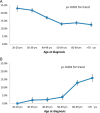The Influence of Patient Age on Thyroid Nodule Formation, Multinodularity, and Thyroid Cancer Risk
- PMID: 26465395
- PMCID: PMC4667162
- DOI: 10.1210/jc.2015-3100
The Influence of Patient Age on Thyroid Nodule Formation, Multinodularity, and Thyroid Cancer Risk
Abstract
Introduction: Although advancing age is known to influence the formation of thyroid nodules, the precise relationship remains unclear. Furthermore, it is uncertain whether age influences the risk that any thyroid nodule may prove cancerous.
Aim: The aim was to determine the impact of patient age on nodule formation, multinodularity, and risk of thyroid malignancy.
Method: We conducted a prospective cohort analysis of consecutive adults (ages 20-95 y) who presented for evaluation of nodular disease from 1995 to 2011. A total of 6391 patients underwent ultrasound and fine-needle aspiration of 12 115 nodules ≥ 1 cm. Patients were divided into six age groups and compared using sonographic, cytological, and histological endpoints.
Result: The prevalence of thyroid nodular disease increases with advancing age. The mean number of nodules at presentation increased from 1.5 in the youngest cohort (age, 20-30 y) to 2.2 in the oldest cohort (age, >70 y; P < .001), demonstrating a 1.6% annual increased risk for multinodularity (odds ratio, 1.02; P < .001). In contrast, the risk of malignancy in a newly identified nodule declined with advancing age. Thyroid cancer incidence per patient was 22.9% in the youngest cohort, but 12.6% in the oldest cohort (odds ratio, 0.972; P < .001), demonstrating a 2.2% decrease per year in the relative risk of malignancy between ages 20 and 60 years, which stabilized thereafter. Despite a lower likelihood of malignancy, identified cancers in older patients demonstrated higher risk histological phenotypes. Although nearly all malignancies in younger patients were well-differentiated, older patients were more likely to have higher risk papillary thyroid carcinoma variants, poorly differentiated cancer, or anaplastic carcinoma (P < .001).
Conclusion: With advancing age, the prevalence of clinically relevant thyroid nodules increases, whereas the risk that such nodules are malignant decreases. Nonetheless, when thyroid cancer is detected in older individuals, a higher-risk histological phenotype is more likely. These data provide insight into the clinical paradox that confronts physicians managing this common illness.
Figures


References
-
- Brander A, Viikinkoski P, Nickels J, Kivisaari L. Thyroid gland: US screening in a random adult population. Radiology. 1991;181:683–687. - PubMed
-
- Acar T, Ozbek SS, Acar S. Incidentally discovered thyroid nodules: frequency in an adult population during Doppler ultrasonographic evaluation of cervical vessels. Endocrine. 2014;45:73–78. - PubMed
-
- Reiners C, Wegscheider K, Schicha H, et al. Prevalence of thyroid disorders in the working population of Germany: ultrasonography screening in 96,278 unselected employees. Thyroid. 2004;14:926–932. - PubMed
-
- Bartolotta TV, Midiri M, Runza G, et al. Incidentally discovered thyroid nodules: incidence, and greyscale and colour Doppler pattern in an adult population screened by real-time compound spatial sonography. Radiol Med. 2006;111:989–998. - PubMed
-
- Guth S, Theune U, Aberle J, Galach A, Bamberger CM. Very high prevalence of thyroid nodules detected by high frequency (13 MHz) ultrasound examination. Eur J Clin Invest. 2009;39:699–706. - PubMed
Publication types
MeSH terms
Grants and funding
LinkOut - more resources
Full Text Sources
Other Literature Sources
Medical

